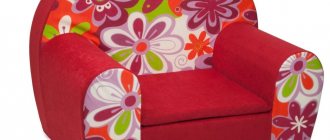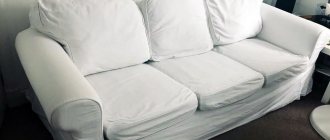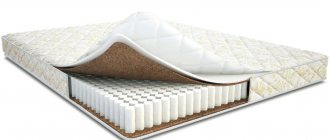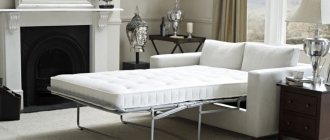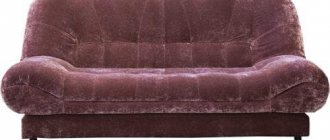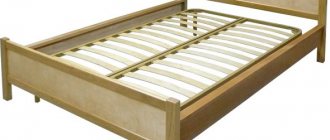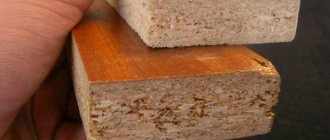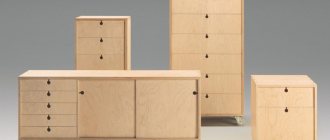This is the performance characteristic of the material. In our case, foam rubber. It is measured in kilograms divided by cubic meters. Or just kg/m3.
I think it is no longer necessary to talk in detail about density, what it is and what the unit of measurement is. This parameter must always be indicated by the manufacturer on the products. Depending on what types of foam rubber are used in terms of density, they can be used in one or another area.
Advantages of foam rubber
It would be fair to say that foam rubber is almost the most popular material in furniture production.
It is used as filling under the upholstery, giving the structure the necessary rigidity, comfort, and softness.
Foam rubber as a filler boasts the following advantages:
- universal material, suitable for different tasks;
- comfortable and convenient;
- has a small mass;
- offered in a wide range;
- easy to process with your own hands;
- suitable for repair, assembly and restoration of furniture;
- has different density parameters;
- long service life.
Polyol and various additives are used in production.
By choosing the appropriate composition, you can make a simple foam mattress yourself, or make something more serious and large-scale. For example, an accordion sofa or a full double bed with a soft headboard.
Only foam rubber whose density exceeds 25 kg/m3 is considered furniture.
All other materials are mainly used in construction, as insulation, etc.
Now let's move on to varieties.
Polyurethane foam (PPU) technical characteristics and properties
In terms of thermal insulation characteristics, foam is superior to many analogues. As a heater it is difficult to find equal. High density and adhesion make the cold insulation capabilities even greater. They depend on the structure of the material. The liquid form has a coefficient of 0.019 to 0.035 W/m K, and the closest similar form, mineral wool, has a coefficient of 0.045 W/m K.
Vapor permeability is also low - closed cells do not let steam inside. For mineral wool, the same indicator is 50 times worse. Foam protects walls and ceilings from harmful influences, maintains the desired temperature inside the rooms and stops water particles from penetrating into the walls. But it is not recommended to use it under liquid or in direct contact with it, as this can cause a hydration reaction.
Comparison with mineral wool
This is the closest analogue, more popular, cheaper and inferior in a number of properties. The compressive strength of polyurethane foam is at the level of 0.3; for mineral wool it is not calculated, since it is a very flexible and obedient material.
Polyurethane foam can absorb no more than 10% of water; mineral wool is not designed for such a load and itself has a constant 4% humidity. It will not resist swelling from liquid, so it is not recommended to use it in residential buildings.
Let's talk about maximum service life. The foam will last at least 40 years, and the level of other substances does not exceed 10. Caked mineral wool simply becomes a harmful gasket that is of no use.
Polyurethane foam does not contain dangerous fumes, formaldehydes and phenols, like its cheaper analogue with 6% of unwanted compounds, and is completely safe. It is resistant to aggressive environments and has excellent resistance to rodents and insects. Polyurethane foam does not release fibers into the air; mineral wool contains an allergen for many people and azone-depleting gases.
Table: 12 characteristics
| Property | Index | Explanation |
| Density | 45-60 kg/m3. | Very light material, even mineral wool has 150-250. |
| Shrinkage | — | Was not identified. |
| Compressive strength | 0.46 mm/m. | An excellent indicator, foam concrete has a similar characteristic. |
| Heat conductivity | 0.021 W/m*K. | Mineral wool has 0.035 less than many analogues. |
| Frost resistance | Up to 1000 cycles. | Excellent feature. |
| Water absorption | 2%. | Better than analogues, foam concrete is up to 20%. |
| Vapor permeability | 0,001. | Almost complete insulation from steam, mineral wool has 0.29. |
| Fire resistance | 3G. | It goes out on its own and lights up poorly. |
| Price | 300-1800. | Depends on the thickness, presence and type of protective layers. |
| Sound isolation | High. | Higher than analogues. |
| Toxicity | Not considered toxic. | Can even be used in food refrigerators; there are no harmful fumes or dust. |
| How many years will it last | Up to 50. | It is considered one of the most durable types of insulation. |
Depending on the indicator they are divided:
- • C – self-damping;
- • Vehicles – difficult to burn;
- • TV – flame-resistant.
To increase fire resistance, special substances are usually added to the composition. It is important to know exactly which ones you can put, but it is better to entrust this to specialists rather than do it yourself.
Types of foam rubber according to its density
So that you are not confused by the complex table and various numbers, I will try to talk about the density of foam rubber more briefly, but at the same time clearly.
There are several main types of this material.
[adv1]
- Standard. Marked with the letters ST. Its density is 16-25 kg/cm3;
- With increased hardness. This is already marked EL. And the density is within 22-35 units;
- Hard. Designated as HL. Its density ranges from 25-50 kg/cm3;
- Soft. HS marking. In this case, the density is 20-45 kg/m3;
- HR. Highly elastic compositions. Often called latex polyurethane foam. Mainly used in mattresses;
- V.E. Highly elastic. It is he who has the memory effect.
A little later I will tell you which PPU can be used for certain tasks.
But it is a mistake to think that when choosing a material you need to look only at the density, which can be 22 kg/m3, 25, 30 units, sometimes even 40.
Qualitative characteristics
The quality of foam rubber is determined by its basic performance characteristics.
These include the following values:
[adv2]
- Density. They've already talked about it. It varies quite widely;
- Rigidity. Or compression stress. This is a characteristic of how much force must be applied to compress the product by 40%. Measured in kPa;
- Strength. Determined by rupture and relative elongation at direct rupture. The first characteristic shows the force, the second the stretch until the moment the polyurethane foam breaks. In the case of standard polyurethane foam, this is 120-140 kPa and 240-280%, respectively;
- Elasticity. It is determined by the fall of a special ball from a certain height. The stiffer the polyurethane foam, the lower the elasticity;
- Residual deformation of polyurethane foam. One of the key characteristics. Determines the ability to maintain shape and size during operation;
- Comfort factor as well as support. Mainly relevant for highly elastic polyurethane foam. The higher the characteristics, the better the quality of the foam.
By the way, it is the density and its rigidity that are usually present in the marking. If the numbers are 2536, this means that the density here is 25 kg/cm3 and the hardness is 36 kPa.
As you can see, they are not united by one density.
But since we are talking specifically about the density of foam rubber, this issue should be studied in more detail.
What, where and why
See also:
What is a furniture damper, what are they, how to install
PPU has a wide range of applications.
With its help, you can build a bedside ottoman, make upholstery for chairs, simply make a soft seat for a shoe rack, or go even further by assembling a full-fledged mattress with your own hands.
By the way, we have already talked to you about the nuances of choosing polyurethane foam for a sofa. Today I would like to touch on the issue of density and consider various furniture.
You can select PPU:
See also
Artificial stone sinks: pros and cons, owner reviews
- for carriage screed;
- sofa;
- for mattress;
- armchairs;
- for car seats;
- for chairs;
- children's furniture;
- for seats;
- ottomans;
- stools;
- banquettes, etc.
I suggest going through the main categories and determining what is suitable for a particular furniture design option.
By the way, people are often interested in how to determine the density of polyurethane foam by color. This is difficult to do. Especially when it comes to furniture material. This is more relevant for construction foam rubber.
Sofas
Let's start with sofas and its varieties.
You shouldn't always go for the highest density. Indeed, with increased characteristics, the surface may turn out to be too hard and uncomfortable.
Now briefly about how to choose the right parameter for a given case.
See also
How to make a key holder with your own hands: 5 simple and ingenious ideas
- If the sofa in the house is used as a sleeping place, a density and hardness level of 28 and 42 units is required, respectively;
- If the sofa is for a seat, 22 kg/m3 and 40 kPa will suffice;
- In the absence of spring blocks, when the sleeping place is completely made of polyurethane foam, material of type EL 2842 or ST 2542 is selected with a material thickness of at least 10 cm;
- For a place load of up to 100 kg, the EL2240 is sufficient;
- Corner sofas with a soft part of pillows are suitable ST3040;
- For dolphin-type sofas, you need material with a thickness of 9-11 cm and with parameters EL2240 or ST2536;
- For guest sofas, rarely used for sleeping, ST2236 or EL 2240 are usually used.
The sofas are sorted out. Now let's talk a little about chairs and beds.
They have their own requirements in terms of selecting polyurethane foam in terms of density and hardness.
Armchairs and beds
Here you can highlight several examples that will allow you to better navigate the issue of choosing suitable polyurethane foam.
See also
Bedside table with legs for the bedroom: modern ideas
The main options being considered are:
- Fixed chairs with seats 5-10 cm thick use the same density as in the case of sofas for seating;
- If the chair folds out and is used for sleeping, then focus on the parameters of sleeping sofas. That is, types EL2542, EL2240 and ST2536;
- For beds, it is generally recommended to take the highly elastic HR option. This is when it comes to a mattress;
- For decorative inserts and bed headrests, ST2236 and EL3040 are sufficient.
The options are truly varied. What exactly is right for you depends on the specific furniture, its operating conditions and expected loads.
Selecting the density of polyurethane foam for spraying
The density of polyurethane foams for spraying varies from 8 to 100 kg/m³ or more, and for each brand of polyurethane foam this parameter is indicated along with thermal conductivity. The areas of application of each specific composition and how to change its density during the production process are constant topics of discussion among spray specialists. But the clearest answer to the question “What density of foam should I choose?” provided by the component manufacturing company.
For example, Khimtrust gives the following recommendations regarding its product line:
- 8-20 kg/m³ - for internal heat and noise insulation, for insulation of interfloor ceilings and under plasterboard, not intended for mechanical stress; cells are predominantly open; thermal conductivity coefficient - 0.35-0.40 W/m•°C
- 20-25 kg/m³ - for external and internal insulation, not intended for mechanical stress, should not come into contact with precipitation; about 50% open cells; thermal conductivity coefficient – 0.30-0.36 W/m•°C
- 30-35 kg/m³ - for external and internal insulation, incl. for backfill foundations no deeper than 2 m, not intended for walking; cells are closed; thermal conductivity coefficient - 0.20-0.26 W/m•°C
- 40-45 kg/m³ - for external and internal insulation, incl. for backfill foundations no deeper than 3 m, not for frequent walking; cells are closed; thermal conductivity coefficient - 0.22-0.28 W/m•°C
- 60-70 kg/m³ - for external and internal insulation, incl. for backfill foundations and used roofs; cells are closed; thermal conductivity coefficient - 0.28-0.34 W/m•°C
- 100-110 kg/m³ - for external and internal insulation, incl. for backfill foundations and used roofs; cells are closed; thermal conductivity coefficient - 0.35-0.40 W/m•°C
When choosing the density of polyurethane foam, you must be guided by the thermal insulation characteristics. The greatest thermal insulation effect is achieved when using foams with a density of 30-50 kg/m³. At a lower density, the number of pores decreases and the size increases, among which there are more open ones. At higher densities, the influence of the polymer network increases. In both cases, thermal insulation deteriorates, although for different reasons.
The density or its range is set by the manufacturer of the raw material, creating a recipe with the optimal ratio of foaming agents, catalysts, stabilizers and blowing agents. Is it possible to change the density of polyurethane foam yourself? Theoretically, yes, it’s not for nothing that experienced polyurethane makers have fascinating stories about adding various activators and/or water to the component in order to reduce density and save on the overall consumption of raw materials. However, this practice is even more vicious than diluting gasoline with donkey urine according to Vasily Alibabaevich’s method.
Changing the optimally selected ratio of ingredients in component A threatens shrinkage of the foam, decreased adhesion to the base, reduced time for the start of foaming, increased porosity and fragility of polyurethane foam, and damage to the entire barrel of raw materials. Therefore, we strongly recommend not to interfere with the composition of the supplied polyurethane foam components and to select the required density in advance and in accordance with the technical documentation attached to a particular brand of raw material. Even if your requirements are individual, you can order components with a non-standard density of the resulting foam and select the optimal density of polyurethane foam for you.
When ordering through the website - 3% DISCOUNT!
Call us and our company’s specialists will help you choose polyurethane foam of optimal density! Consult!
Tags
- density of polyurethane foam
- spraying of polyurethane foam
- Components
- saving
- ratio
- external
- internal
- foundation insulation
Similar materials (by tag)
- Insulation of hangars with polyurethane foam, polyurethane foam
- Is a vapor barrier necessary when spraying polyurethane foam in a frame house?
- How to protect polyurethane foam applied to the roof?
- How to prepare a surface for spraying polyurethane foam?
- Top 10 mistakes in spraying polyurethane foam
Other materials in this category: "On the differences between freon and water systems (in detail) We calculate the consumption of raw materials when spraying polyurethane foam"
Top
